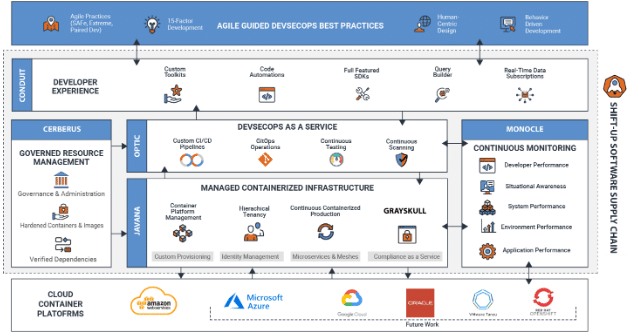
By Mark Wells, VP, DevSecOps Center of Excellence
People ask me, “Can you define DevOps?” DevOps has been around for more than 20 years. This should be a straight-forward answer by now. The reason it isn’t is because of the continuous development of new concepts, ideas, methodologies, techniques, and processes used by marketing and engineering teams to differentiate their unique capabilities from other competitors. Truth is, this cornucopia of buzzwords is not actually anything new, but more of a variation on the existing theme of DevOps. So, let’s clear up the confusion.
What We Have Learned Over Time
With any system, there is always the need for improvement and DevOps is no different. In fact, we demand it. Initial operating procedures for DevOps enterprises were daunting and complex, causing DevOps engineers many sleepless nights working through the intricate combinations of possible tool interactions and integrations. The results are new operational concepts that have been added to the lexicon of DevOps:
- DevSecOps – includes security
- Orchestration – automation
- Software Supply Chains – an automated method for delivering software to production using DevOps
- Site Reliability Engineering (SRE) – a way of ensuring all DevOps systems are tuned and performing at optimally
- Software Factories – standardizes tools and techniques used for DevOps
- Platform Engineering – uses a high-level tool to manage DevOps using Self-Service
- Platform as a Platform (PaaP) – automates and simplifies the development of core components to reduce coding (sometimes Low-Code is included here)
There are many other terms as well that have come about over time. In all cases, they are nothing more than an improvement to the original ideas of DevOps and Agile. So, how do all these buzzwords relate to one another?
A Modern Approach to DevOps
The simple answer is, automate everywhere you can. DevOps gave us Continuous Integration/Continuous Delivery/Deployment (CI/CD) and Continuous Testing followed by Continuous Security and Observability. The “New New” is nothing more than the concept of Continuous Everything (CE). Let the computer, the AI engine, and workflow processes do the heavy lifting of DevOps. Let the developer develop. Let the engineer monitor and enhance.
It doesn’t matter what buzzword we use to describe it. What matters is that there is an automated enterprise architecture that delivers the necessary infrastructure, tooling, monitoring, quality process management (e.g., Agile), security, and accessibility of services. This will ensure an enterprise operates at the maximum efficiency in providing capabilities to their stakeholders and customers. Several federal departments have moved down this path creating software factories (e.g., Air Force Kessel Run & Platform One, US Navy Black Pearl, US Army CReATE, etc.) and platforms (e.g., Rancher, D2iQ, VMWare Tanzu, Red Hat OpenShift, etc.) to support modern software engineering DevOps.
Octo Delivers the New New for DevSecOps
At Octo, an IBM Company, we have delivered on this New DevOps ideal as well. Our Shift-Up® Platform Engineering Software Supply Chain Factory gives you the DevOps self-service simplification of standardized enterprises that automates the development and delivery of applications to federal policy that mandated secured production environments. Shift-Up delivers all necessary infrastructure and tool configurations for even the most complex enterprise environments in 30-45 minutes, reducing days to weeks of repetitive work for each operational system through Continuous Everything automation.
Shift-Up® provides Infrastructure as Code, Configuration as Code, Compliance as a Service (Security), and DevSecOps as a Service, all from a simple UI web interface. As shown in the Shift-Up architecture graphic, Cerberus ensures that only secure and authorized infrastructure components and code frameworks are used. Javana builds standardized enterprise environments based on department, agency, or organizational policy mandates. Optic delivers fully automated CI/CD pipelines fully integrated and delivers software supply chain operations. Monocle provides observability and performance monitoring of your systems, while Conduit automatically writes large amounts of code based on the technical architecture. Conduit also gives you an SDK that simplifies development to single lines of code that can perform whole classes of functionality.

Remember, the buzzwords don’t matter. How you implement them in an operationally effective manner does. Shift-Up® is the platform that makes it happen to ensure operational success, easy sustainment, and the ability to adapt to the ever-changing future.


